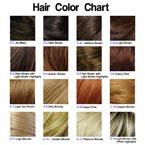New hair colour products provide greater range of options
 Hamburg - Too dull, too limp, too plain or simply too grey - most women become exasperated with their hair at some point and when that occurs they soon march into a drug store for hair dye products or go straight to their hair dresser for professional help.
Hamburg - Too dull, too limp, too plain or simply too grey - most women become exasperated with their hair at some point and when that occurs they soon march into a drug store for hair dye products or go straight to their hair dresser for professional help.
Colour or highlights should create new brilliance and body in the hair. Whether the colour is platinum blond or chestnut brown, the colour products available today don't strain the hair the way they used to. But which product is best for what type of hair and when the hair actually is suffering under the use of hair colouring products are questions for an expert.
"First you have to clearly divide women who colour their hair into two groups: those who want to cover their grey hair and those who want to do something stylish with their hair," said Jens Dagné of Worms, Germany, and a member of the board of managers of a German association of hair dressers.
When the woman's goal is merely to add some spice to her own natural hair colour, which she might find boring, then she should choose a tint, which washes out after five to eight weeks depending on the quality of the product and how frequently the hair is shampooed.
When a tint is used colour pigments are attached to the hair, said Franz-Josef Kueveler, art director of the central association of German hairstylists in Cologne. "It can be used to give one's natural hair colour a someone different direction. But it doesn't cover grey hair."
The advantage is that the colour pigments don't penetrate the hair and thus a tint can be less harsh than hair dye. Aside from that, if the new hair colour doesn't suit, it disappears within a few shampoos. In addition, the regrowth is hardly noticeable because the colour washes out by the time the hair grows out and the difference between the hair that has been tinted and the new hair is barely visible.
But experimentation with hair tints at home in the bathroom can go awry. Depending on the thickness and texture of the hair and the length of time the product is left in the hair, the end result can look different from the picture on the package.
"The name of the product also can be confusing and might leave someone wondering whether it's a tint or dye," said Stefanie Koehn of the association of German hair stylists in Stuttgart. Dyes are always a bit riskier.
"The dye fuses itself chemically into the hair and stays," said Kueveler. It can't be washed out, and correcting it by colouring over is also difficult to achieve.
To cover up bothersome grey strands, dye is the most sensible solution. But if the length of time the product is left in the hair to work isn't right, the chemical process is not properly interrupted and neutralized. Then when it's time to colour the roots, or regrowth, a different colour can appear in the overlapping hair and the hair generally can suffer, said Kueveler.
Products available today are, however, basically gentler than their predecessors. While hair colour products once left hair dry and straw-like with little brilliance, today they tend to be much better for the hair, say the hair experts.
"Thanks to the latest nanotechnology there are now dyes that are good for the hair and improve the quality of the hair rather than damage it," said Koehn.
In addition, numerous techniques have been developed that actually blend and allow stylists to play with colour. A basic tint can be put in the hair, and highlights worked into it. Another technique involves so-called hair painting that can be used to create shadows in the hair.
Finally, women who persistently colour their hair should use shampoos intended for coloured hair.
"These types of shampoos close off the hair's dandruff layer," said Kueveler. Thus the colour pigment that has worked into the hair doesn't slough off as quickly and the colour stays in the hair longer. There also are products that are meant to protect coloured hair from harmful sunlight. (dpa)